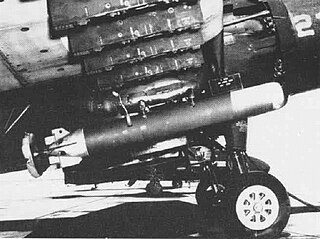| Mark 32 torpedo | |
|---|---|
Diagram of the Mark 32 torpedo | |
| Type | Acoustic torpedo [1] |
| Place of origin | United States |
| Service history | |
| In service | 1950-1955 [1] |
| Used by | United States Navy |
| Production history | |
| Designer | General Electric [1] Ordnance Research Laboratory, Pennsylvania State University |
| Designed | 1950 [1] |
| Manufacturer | Philco [1] Naval Ordnance Station Forest Park Leeds and Northrup |
| No. built | 3300 [1] |
| Specifications | |
| Weight | 700 pounds [1] |
| Length | 83 inches [1] |
| Diameter | 19 inches with 25.4-inch fins [1] |
| Effective firing range | 9600 yards [1] (24-minute search duration) |
| Warhead | Mk 32 Mod 1, HBX [1] |
| Warhead weight | 107 pounds [1] |
Detonation mechanism | Mk 19 Mods 4 and 11 contact exploder [1] |
| Engine | Electric [1] |
| Speed | 12 knots [1] |
Guidance system | Helix search [1] |
Launch platform | Destroyers and aircraft [1] |
The Mark 32 torpedo was the first active acoustic antisubmarine homing torpedo in United States Navy service. [1] The Mark 32 was withdrawn from service use with the introduction of the Mark 43 torpedo.

An acoustic torpedo is a torpedo that aims itself by listening for characteristic sounds of its target or by searching for it using sonar. Acoustic torpedoes are usually designed for medium-range use, and often fired from a submarine.

The United States Navy (USN) is the naval warfare service branch of the United States Armed Forces and one of the seven uniformed services of the United States. It is the largest and most capable navy in the world and it has been estimated that in terms of tonnage of its active battle fleet alone, it is larger than the next 13 navies combined, which includes 11 U.S. allies or partner nations. with the highest combined battle fleet tonnage and the world's largest aircraft carrier fleet, with eleven in service, and two new carriers under construction. With 319,421 personnel on active duty and 99,616 in the Ready Reserve, the Navy is the third largest of the service branches. It has 282 deployable combat vessels and more than 3,700 operational aircraft as of March 2018, making it the second-largest air force in the world, after the United States Air Force.

The 10" Mark 43 torpedo was the first and smallest of the United States Navy light-weight anti-submarine torpedoes. This electrically propelled 10-inch (25-cm) torpedo was 92 inches long and weighed 265 pounds (120 kg). Described as "a submersible guided missile", the torpedo was designed for air or surface launch. The Mod 0 configuration was designed for launch from helicopters or fixed-wing aircraft, and the Mod 1 configuration was for helicopters only. Both were electrically driven and deep-diving, but had relatively short range. They were classified as obsolete in the 1960s.
Ten were manufactured by Leeds and Northrup, Philadelphia during War II, and about 3,300 were manufactured by a combination of the Philco Corporation, Philadelphia, and the Naval Ordnance Plant, Forest Park, Illinois. [1]
Philco was a pioneer in battery, radio, and television production. In North America, it is the Philco brand owned by Philips. In other markets, it is the Philco International brand owned by Electrolux.
Naval Ordnance Station Forest Park (NOSF) was in Forest Park, Illinois. It was founded during World War II (1942-1945) as Naval Ordnance Plant Forest Park (NOPF). The Forest Park Station was instrumental in building torpedoes for the Navy, employing up to 6,500 workers and producing 19,000 torpedoes. Torpedo production was halted in 1945 and research and development was performed until the main plant was shuttered and converted into a mall in 1971. The remaining facilities were turned into a Naval Reserve Center until it was finally closed in April 2007.

Forest Park is a village in Cook County, Illinois, a suburb of Chicago, United States. The population was 14,167 at the 2010 census. The Forest Park terminal on the CTA Blue Line is the line's western terminus, located on the Eisenhower Expressway at Des Plaines Avenue.
















